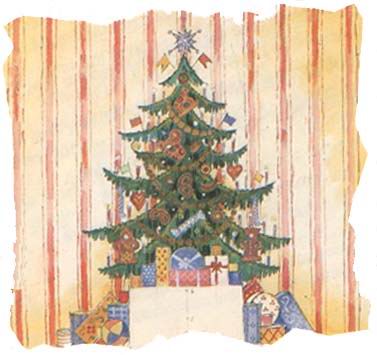
Above: A proposed sketch of the Christmas tree in the opening scenes of the Nutcracker Suite.
NUTCRACKER SUITE |
Ballet Suite Op. 71 A |
|
Above: A proposed sketch of the Christmas tree in the opening scenes of the Nutcracker Suite. |
The Nutcracker Suite was based on one of Offenbach's Tales of Hoffman.
The concert suite, which was featured less than a quarter of the original ballet
score,
was performed nine months before the first showing of the ballet itself. The
subject did not hold immediate appeal for Tchaikovsky, but he found that the
more he worked on it, the more his enthusiasm for it grew.
The ballet suite was first performed at the Maryinski Theatre, St. Petersburg,
in December 1892, and was given a fairly cool reception. This was in marked
contrast
to the orchestral version, which was so well received that almost every piece
was greeted with a demand for an encore.
In Europe, the ballet went unnoticed, receiving its first performance in London in 1934. The ballet has since gained in popularity, and is a favourite form of Christmas entertainment.
---------------------------------------------------------------------------------
|
Above: The stage design for the London Festival Ballet for the Nutcracker Suite, Act II, to conjure up the fantasy atmosphere of the Kingdom of Sweets. |
The Nutcracker Suite takes us on a journey into the most inspired and fanciful landscape imaginable - the Kingdom of Sweets - where snowflakes dance and fountains flow with honey.
It is Christmas Eve, and Clara is given a strange old nutcracker with a gnarled human face for a present. Later that night, she steals downstairs to look for her nutcracker, only to discover all the toy soldiers battling against the mice led by their cruel, many-headed king. Clara valiantly drives all the mice away and declares her love for Nutcracker, thus freeing him from his spell and transforming him back into a handsome prince. He then whisks Clara off to be his bride in the magical kingdom of Sweets.
Magical Atmosphere
The Nutcracker Suite which is based on a French adaptation of E.T.A. Hoffman's
The Nutcracker and the King of the Mice and faithfully conjures
up the magical atmosphere of the original fairy-tale.
The Miniature Overture, which introduces the suite, at once conveys the adventurous and fanciful nature of what is to follow. Sections of the orchestra intermingle, exchanging melodic and rhythmic phrases with one another, creating ever-new contrasts in texture. The overture is light and graceful - the lower ‘earth-bound' cellos and double basses being noticeably absent.
Mood follows upon mood, colour upon colour in a breathtaking fantasy of magic and adventure. Such contrasts sustain the suite throughout without let-up: from the restrained elegance of the March to the energetic verve of the Russian Dance - a spirited Cossack folk melody that progresses faster and faster to its explosive climax; from the light and graceful Dance of the Reed Pipes, played by three toy flutes, to the eerie and sinister atmosphere of the Arabian Dance, in which one can visualise the Mouse-King as he makes his menacing advance.
The Dance of the Sugar Plum Fairy is, perhaps, the best known of all the dances in this suite - its fairy-like atmosphere conjured up by the delicate bell-like melody of the celesta (a small bell-like sounding keyboard instrument similar to a xylophone. Tchaikovsky was one of the first composers to use it), which was new to the orchestra at the time. A sinewy bassoon line at the bottom intensifies the mood of enchantment, providing additional depth and range.